The day had finally arrived. Today we were leaving for our cruise! Back in the spring, in anticipation of our retirment, we wanted to plan a significant trip. After looking around on the internet, we found a "Summer" cruise arond South America's Cape Horn from Santiago, Chile to Buenos Aires, Argentina. When decided to book it, we found that there was a variation that allowed us to cruise off the coast of Antartica, BUT...it was over Christmas. We talked to our son and asked what he thought about us being gone at Christmas. He asked where and we told him. His response was can I come? And so our Antarctic Adventure was born!
All didn't go smoothly in the planning. Our son couldn't commit early on because he was in the midst of a job search and didn't know if he'd have vacation. We didn't know exactly when we would retire, but decided it would be before the cruise departed in December. So we booked a room for 2 that had the ability to accomodate 4. Then in early November, our son committed. We were very excited that he would be with us. But by this time airline flights to Santiago were scarce and though we were on Delta, he had to fly American. So now we had the added stress of reconnecting at the Santiago Airport... and worrying that both flights would arrive relatively on time.
So here we are. Our son's flight takes off first. His is not direct, stopping first in Miami and then on to Santiago. We drop him at the Atlanta domestic terminal, drop off the rental car, and head for the Atlanta international terminal for our direct flight. There is a shuttle bus directly from the rental car park to the international terminal, which is quite convenient.
Since we live north of Atlanta, you might ask why we would have a rental car. Well, we didn't really want to park our car at the airport for the 3 weeks we'd be gone (at $10.00 per day) and there really is no shuttle service from our town to ATL, so Barry suggested we see what a rental car would cost. So for about $30.00 each way, we could rent a car. Problem solved.
So back at the international concourse, we checked our bags curbside and headed in to go through security, find our gate and eat dinner. We went through security, which essentially has no TSA precheck, and discovered that our gate was actually back in the domestic terminal. The new internationl terminal is quite upscale with lots of duty-free shops but with a limited number of restaurants. So we decided to get on the Plane Train and head to Terminal E. We ate dinner and found our gate then settled in for a long wait until our 9 hour flight.
As always, when you have a night flight, you have high hopes of sleeping. We were in Delta+ in an exit row, so while we had plenty of room (and leg room) humans were not meant to sleep sitting up. Or as Barry put it, the seats were designed by the former East German Stasi (secrect police) as a means of torture through sleep deprivation. We tried valliantly to sleep, but it was not meant to be and, at best, we napped maybe 30 minutes. When we "woke" up I felt like the stewardess had come by and poured sand in my eyes. But, in spite of that, it was a great flight and the folks at Delta were great.

|
On our flight to Santiago
*-*-*
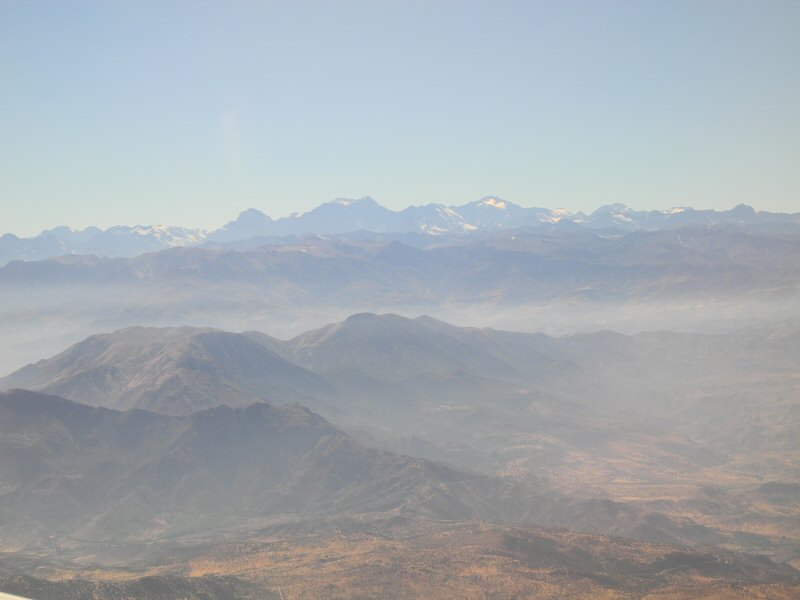
|
A View of the Chilean Andes as we come into Santiago
*-*-*
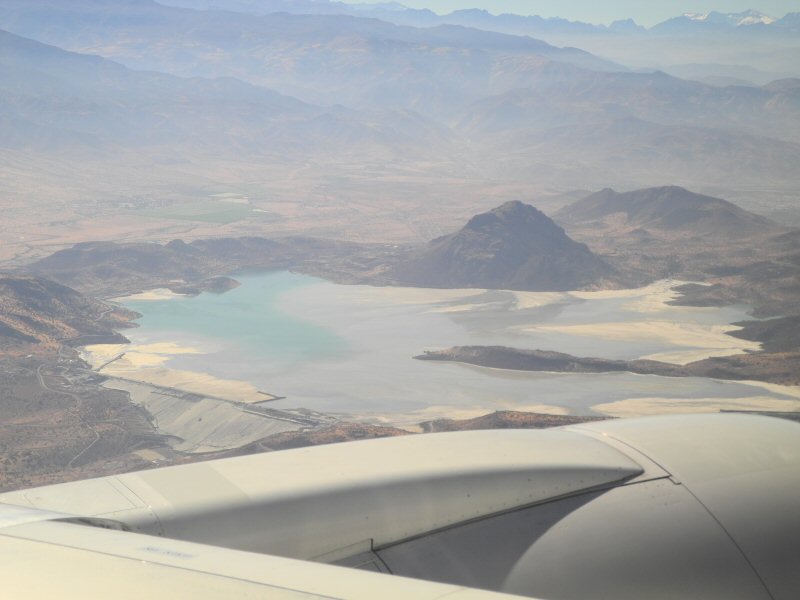
|
A Partially Frozen Mountain Lake near Santiago
*-*-*
Nothing can prepare you for Santiago SCL airport. It was a most interesting experience getting through immigration and customs (two different experiences and two different lines). You exit your plane into a long hallway and you start walking. There is really only one way to go and finally you get to the stairs down to immigration. The line actually started in the hallway before the top of the stairs and went down the stairs wrapped into the immigration lobby and then snaked back and forth at least a dozen times.
It was hot at one end and cool at the other (where there were open doors). There were 15 or so immigration booths. We stood in line almost 2 hours to get up to the agent. They laboriously type specific info into their computer, stamp your passport and then hand you your passport and a stamped receipt that looks like a grocery store receipt (hint - don't lose that as you have to turn that into the cruise ship and possibly other places if you stay in Chile). Then you walk through the Duty free shop and into baggage claim.
Warning: each person over 18 has to fill out a customs form. You cannot bring more than one computer, one camera, one cell phone, one recording device person (according the form). They are also sensitive about agricultural products including foodstuffs - no dried fruit, nuts, grains, vegetables, fruit, etc. So we each had an Ipad, camera and cell phone. One of us had a laptop. So laptops and Ipads are ok together. We also had bottled water and that was okay. But we had gotten rid of our granola bars and trail mix!
As you are headed to baggage claim, be sure you remember your baggage claim number because this is another really big room with no markings for flight numbers and you have to find the right one. I got the impression that there were a dozen overseas flights landing at the same time from the mass of people milling around baggage claim and standing in line. You find you luggage and load it on a free (yes, free) cart and find the end of the line for the customs check. This line went a little faster since there were one or two lines per baggage claim area but it still took about 30 minutes. You hand in your customs form (handed out on the airplane) and load all your bags and personal items on the X-Ray belt. They look at everything but I never saw them pull aside any bags for special screening or inspection.
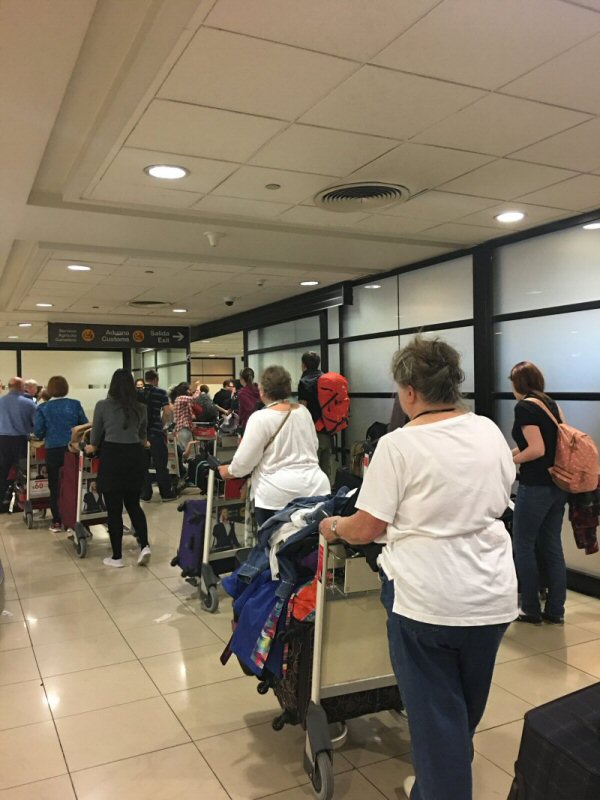
|
Waiting in the Custom's Line at the Santiago Airport (SCL)
*-*-*
Once you are free to exit the airport, you are set upon by taxi and mini-bus drivers vying for your business. In our case, we connected with the Holland America folks for transfer to the ship. They moved the group to another area of the airport to stage us for the trek to the bus. At this point we finally passed a number of small shops selling drinks, food, magazines and so forth. After we got to the waiting area, I went and purchased some soft drinks for our hour or so drive to the cruise terminal. Chilean pesos (cp) only! Two 16 oz diet cokes cost me 3000 cp. At the time of our trip 5000 cp was the equivalent of US$7.75.
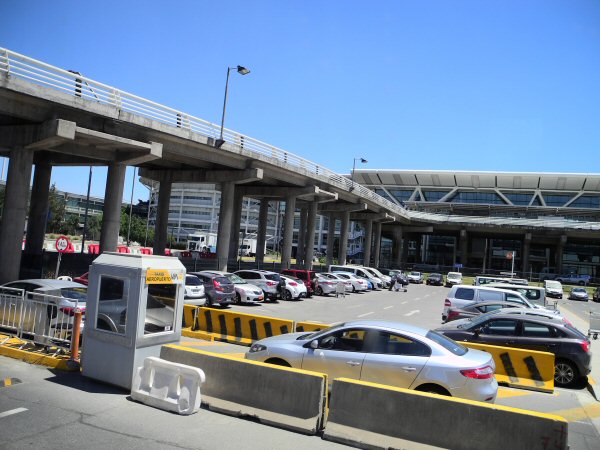
|
Santiago International Airport (SCL)
*-*-*
After a small wait, we were led out with out baggage to a truck where we turned in our bags and then boarded a waiting bus. In an unusual move, for this cruise, even with the Holland America luggage tags, you had to carry your own bags from baggage claim to the truck (using the free carts, of course) however there were a number of indignant passengers that were really upset by this. I suspect it was related to airport security regulations or available infrastructure. Once on the bus we headed for the port city of San Antonio, Chile.

|
The Coastal Foothills on the Drive from Santiago to San Antonio, Chile
*-*-*
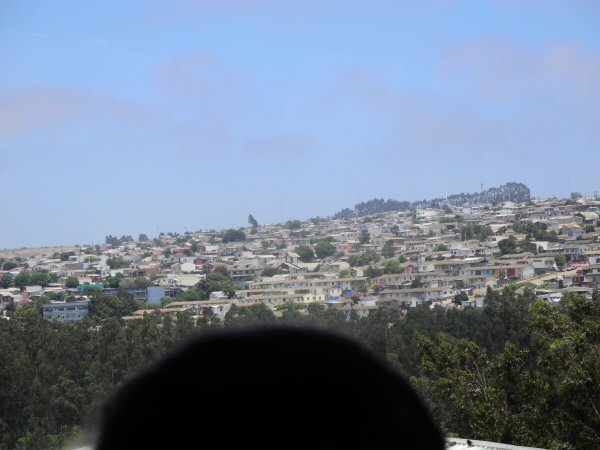
|
Houses in the Port City of San Antonio, Chile
*-*-*
When we arrived at the port things went smoothly. We had preregistered, so they had all the information. We just had to present passports and our immigration receipt. I am glad we had not lost they since they seemed so insignificant when immigration had handed them to us.
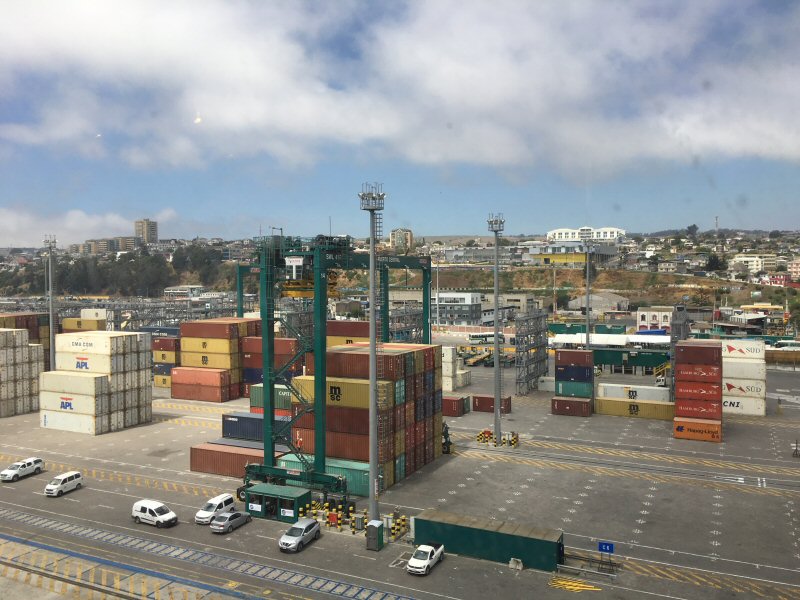
|
A View of the port, San Antonio, Chile
*-*-*
The first evening our mission was to stay awake until it was respectable to go to bed in spite of not having slept much on the plane. We were helped by the +2 hour time change from Eastern time zone. We got acquainted with the ship, spent a little time reading in one of the lounges, got our luggage delivered to the room and emptied the suitcases so they could be stowed. The usual first day activities including meeting our cabin steward Anto from Indonesia. Then we went to dinner in the Rotterdam dining room. Barry and I like to "dress for dinner" and show up at the appointed time to eat. So we try to go to the dining room every evening. We met our servers, Neoman and Doli, for the cruise.
After dinner, with full tummies, we went back to the room and, in spite of it only being 8 pm, were rocked to sleep with the motion of the ship and slept through the night.
Dec. 16, 2017: This is our first "Day at Sea" with no ports of call and we continued getting acquainted with the ship. It is also our first gala dress-up night for dinner.
This day we are sailing down the west coast of South America to Puerto Montt, riding the Humboldt Current, a cold water current running north. The wind was also hitting the ship about 35 degrees off the stern. The ship, in spite of the stablizers, rolled sided to side as well as riding the waves. As it would come out of a swell it would slap the bow down on the water. A number of people on-board suffered from sea-sickness and we all walked like drunken sailors because of the ship's motion. An interesting day, indeed. The grapevine indicated that it might be as rough or rougher in Drake's passage on our trip to Antartcia.
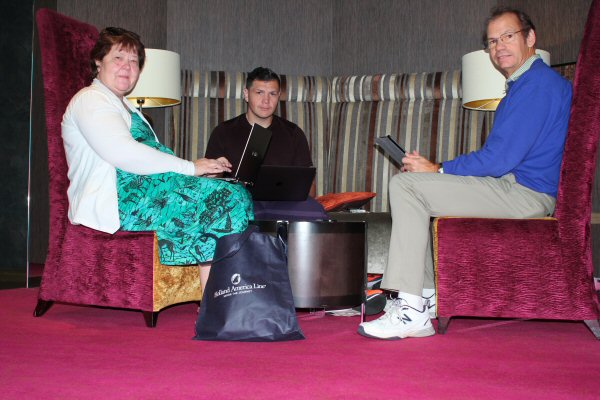
Reading and relaxing on the ship on our first full day aboard.
*-*-*
|
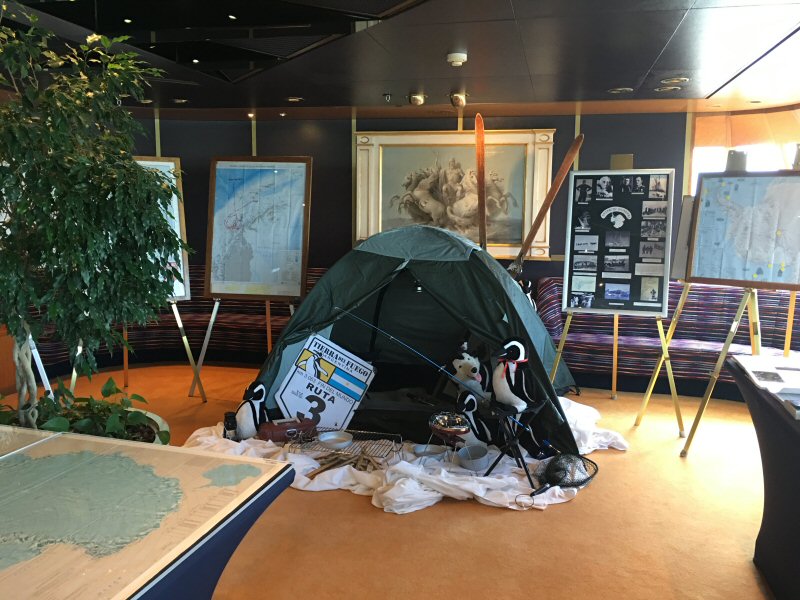
In the Crow's Nest we found an exhibit, prepared by the expedition team, on the Antarctic with maps, books, and information about geology, plants and animals. This was set up in the center of this area.
*-*-*
|
Dec 17, 2017: Puerto Montt, Chile. We have a shore excursion to Puerto Montt, Puerto Varas and the Frutillar Highlands and are really excited to learn something about the region. This port and the next 2 are "tender" ports, meaning you can't just walk straight off the ship. You have to board a small boat (tender) that ferries you to the port. Of course there are lots of folks who want to get off the ship and only so many seats on each of the four tenders. You report to a particular area and they call your tours at the alloted time allowing your whole tour to go on the same tender. Additionally they are allowing some tender slots for the folks who are not taking a tour. The first day of tendering was controlled chaos, but as everyone got the hang of the process, by day 3 of tendering, it was very smooth!
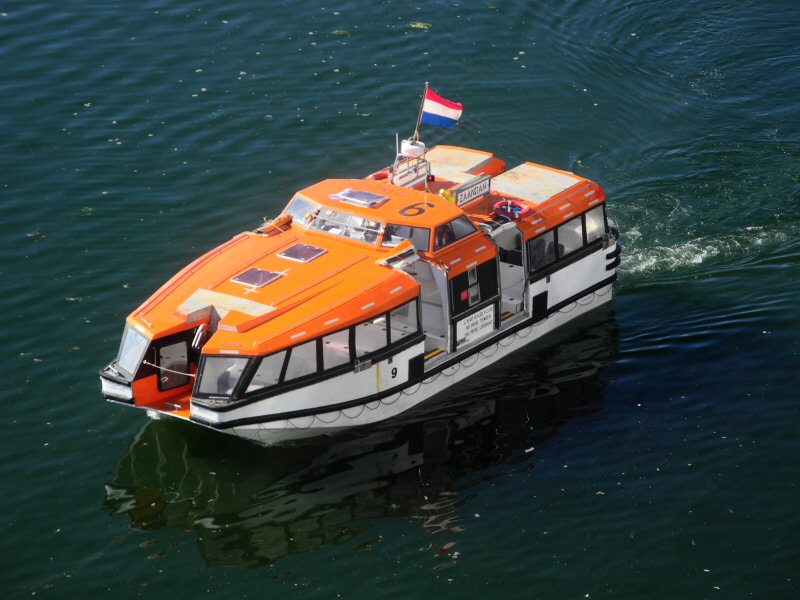
One of the Zaandam's Tenders crossing the bay.
*-*-*
|
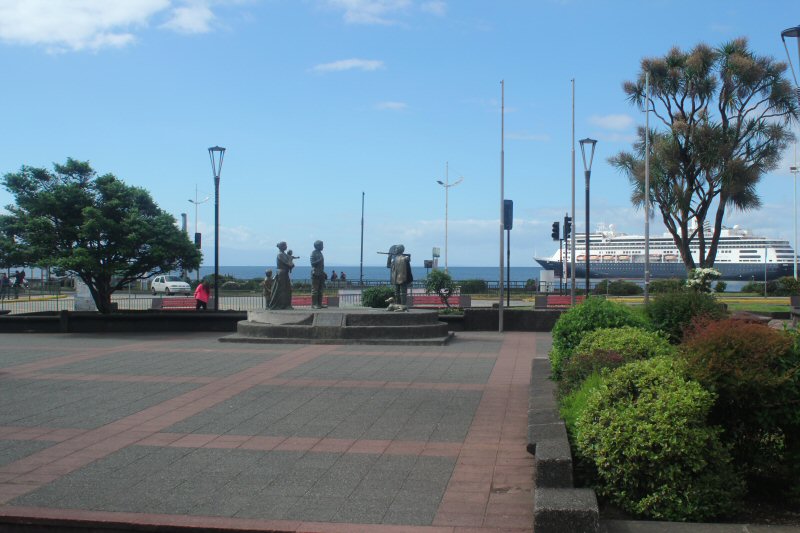
This region of Chile was settled by German settlers invited by the Chilean Government in the 1850's. This is a monument to the settlers and indigenous peoples in Puerto Montt.
*-*-*
|
Puerto Montt is a city built on four levels up the side of the mountains with the lowest level being the oldest part of the town. After touring through the city, we continued on through the lush Chilean countryside to Puerto Varas, where the German influence is more in evidence. This side of South America receives a tremendous amount of rain iand is very dense with vegetation and beautiful blooming flowers, bushes and trees. Puerto Varas is a village near the Osorno and Calbuco Volcanos. It sits one the edge of Lake Llanquihue (Yan qwi hay). Both the volcanoes and the lake dominate the region. Many tourists come to take advantage of the area's natural resources for hiking and skiing.
Here we visited a handicraft market where Lori bought a beautiful heavy sweater in red and black with a penguin motif. After that we walked by the lake and then found a German coffee house and had a coffee, hot cocoa and a wonderful slice of German Hazelnut cake. Apparently the German settlers packed their dessert recipes!
This also afforded us the opportunity to practice our newly aquired skill of speaking very rudimentary Spanish. I negotiated my sweater purchase in Spanish/English. I think the proprietress was excited that I at least tried! At the restaurant, it didn't go quite as well since I didn't know the words for cake or piece, but we did okay with the drinks and asking for the bathrooms. We did discover that the standard restaurant tip is 10% which is shown added to the bill when it is presented to you. You can decline to pay it. Our two coffees, 1 hot cocoa and large slice of cake (portions are very generous) with tip was 11,500 cp. My sweater was 20000 cp (or about US$30.).
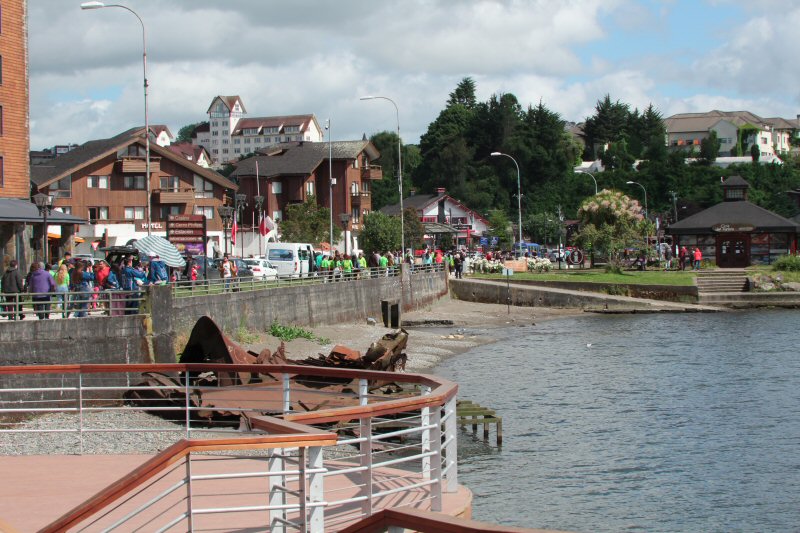
Puerto Varas by Lake Llanquihue. It looks like a small German village!
*-*-*
|
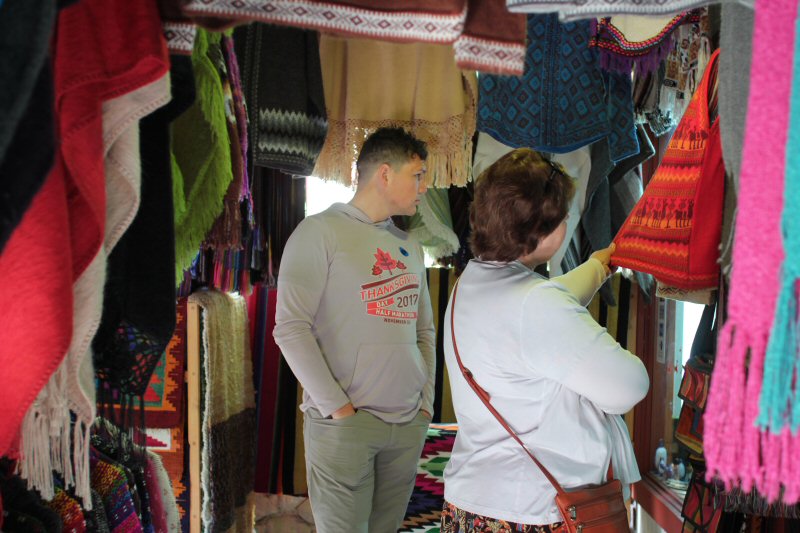
Puerto Varas Artisenal Feria (Handicraft Market)
*-*-*
|
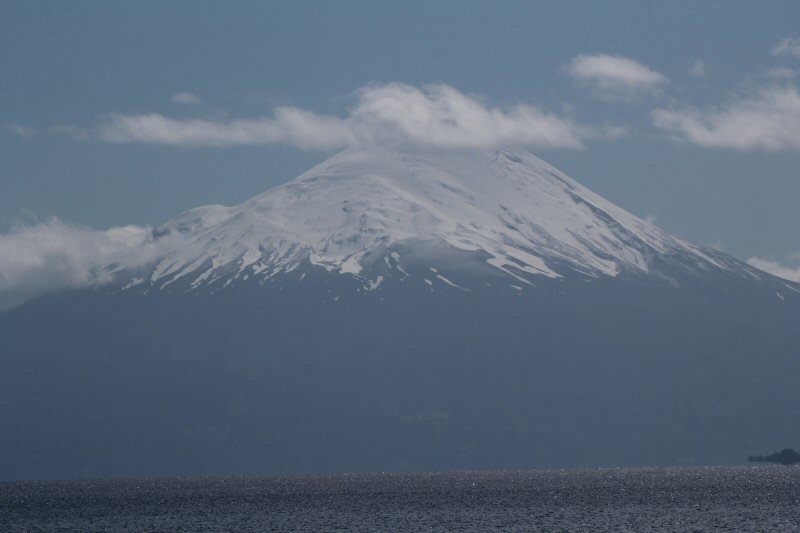
A close-up of the Calbuco Volcano across Lake Llanquihue from Puerto Varas
*-*-*
|
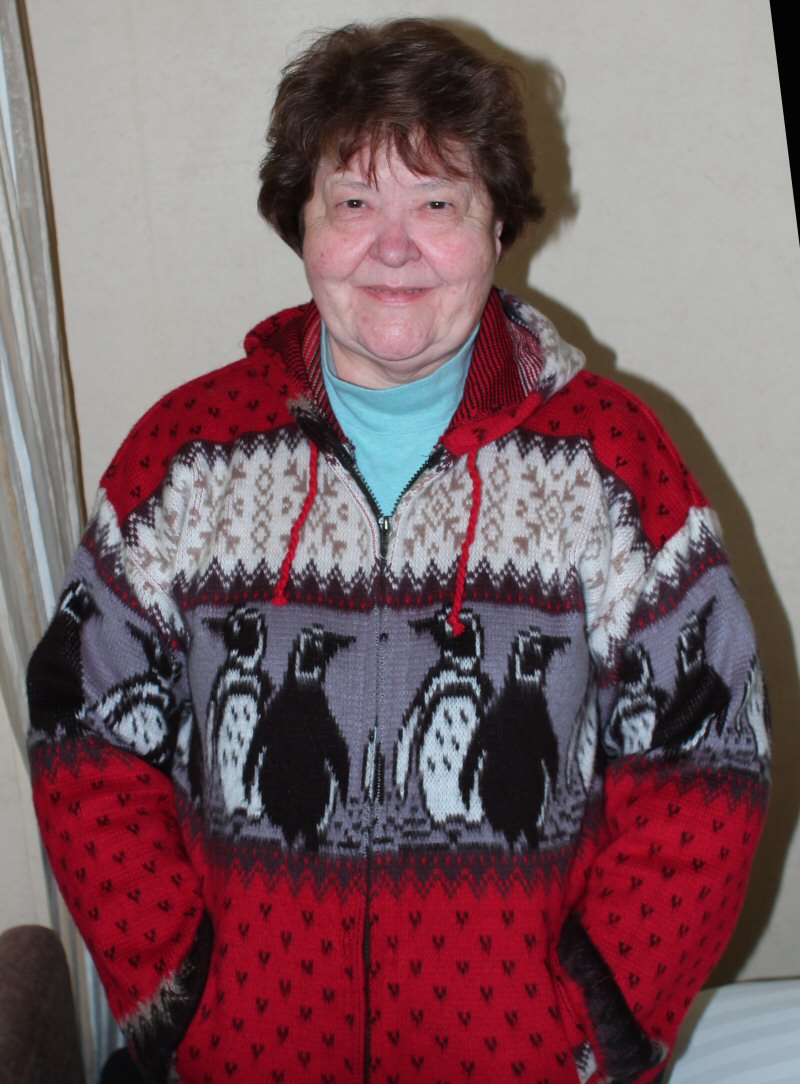
Lori's Penguin Sweater-Jacket from Puerto Varas, Chile
*-*-*
|
Next we drove on to Frutillar, which we found means strawberry. This is another town with strong German influences located on Lake Llanquihue. There is a German Folks Museum located here which we toured and we walked along the lakeshore and enjoyed the shops and views. Also in many of these towns have German clubs. There are also, typically, both Lutheran and Catholic churces in every town in this region. After our stop in Frutillar we headed back to the ship and sailed on to our next port of call.
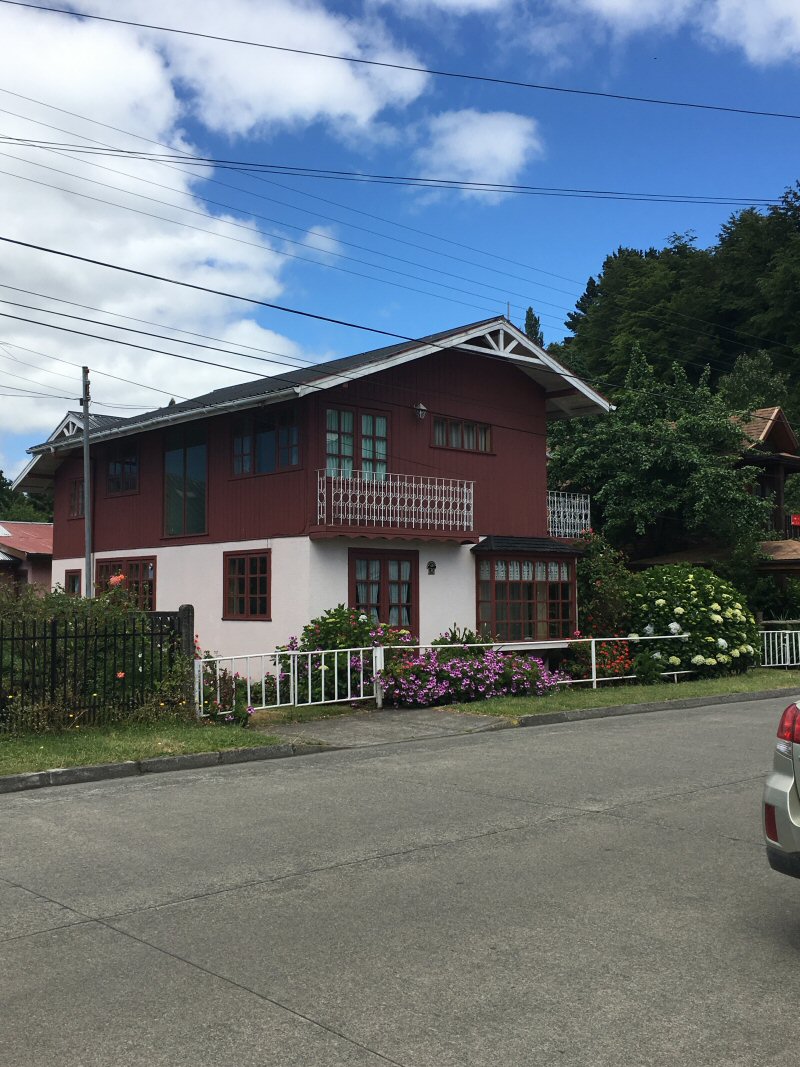
This house, located in Frutillar, reminded me of Germany.
*-*-*
|
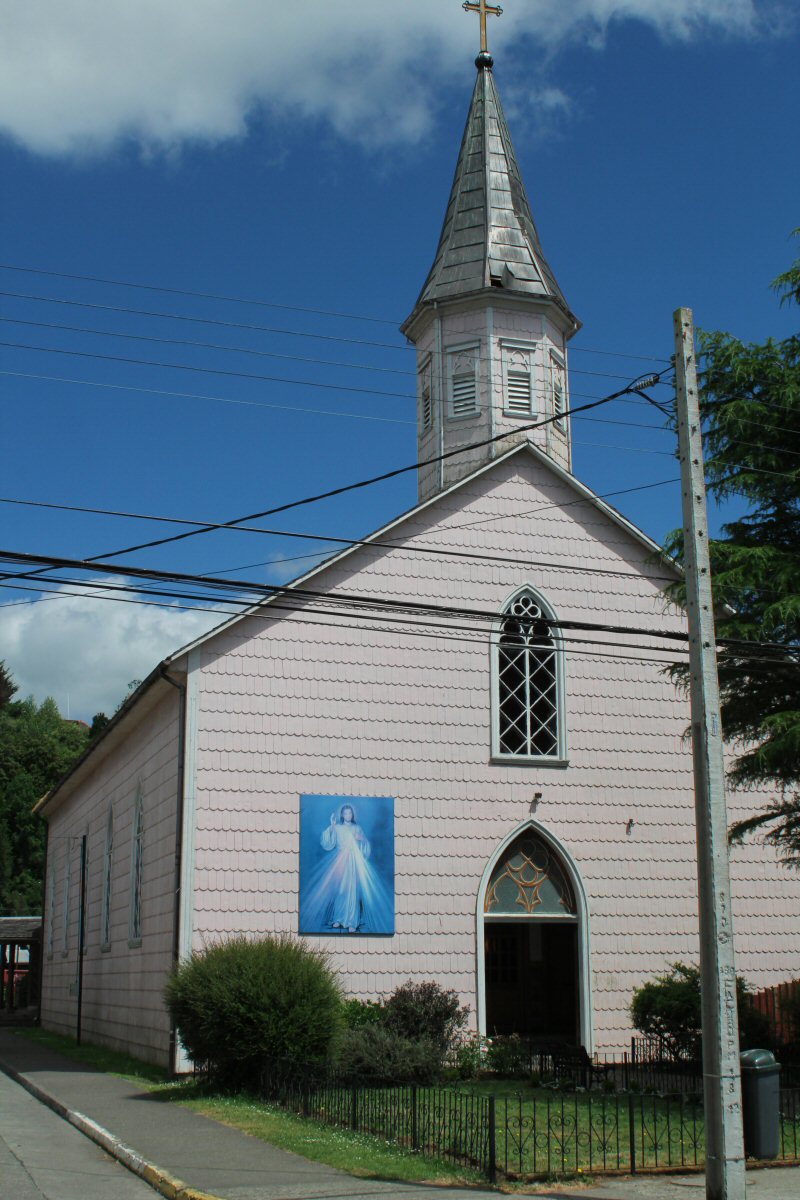
The Lutheran Church in Frutillar with distinctly South American features.
*-*-*
|
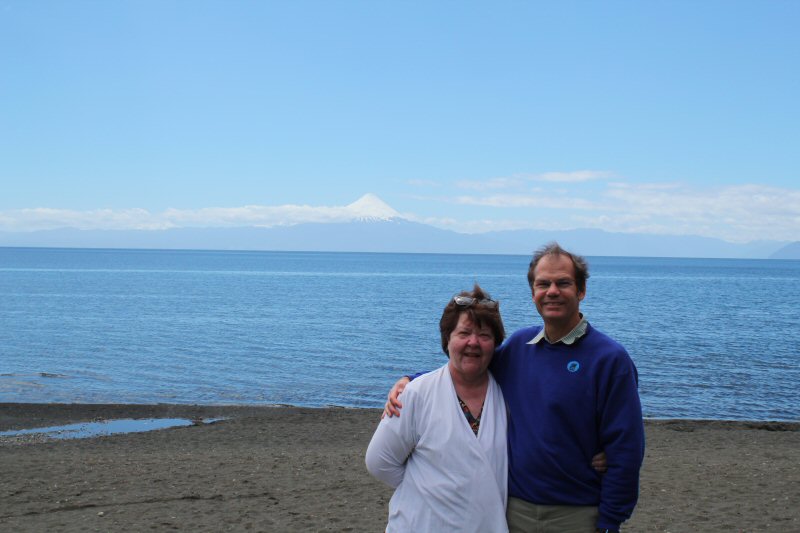
On the shore of Lake Llanquihue with the Osorno Volcano in the background in Frutillar.
*-*-*
|
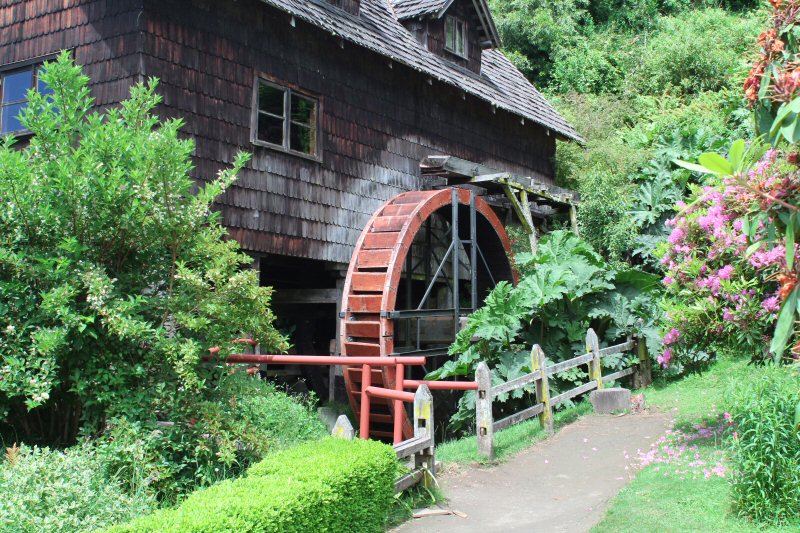
An early water wheel for powering a mill in the German Folks Museum in Frutillar.
*-*-*
|
Dec 18, 2017: Castro, Isla Chiloe, Chile. This is an island village which is very picturesque. We decided to not do a shore excursion, lounge aboard the ship until after eating lunch and then go ashore. I had found an internet cafe/coffee shop on Trip Advisor and there was another handicraft market to look through. Yet another opportunity to speak Spanish! This time Barry asked for 3 Diet cokes. We both felt that the Spanish we had learned, as basic as it was, allowed us to understand signs and feel more confident in navigating the towns more confidently. Also, although we still couldn't understand much of what servers were saying, we did have the ability to try to interact with them in their language, rather than expecting them to only speak ours. It was really empowering and I think the servers enjoyed it!
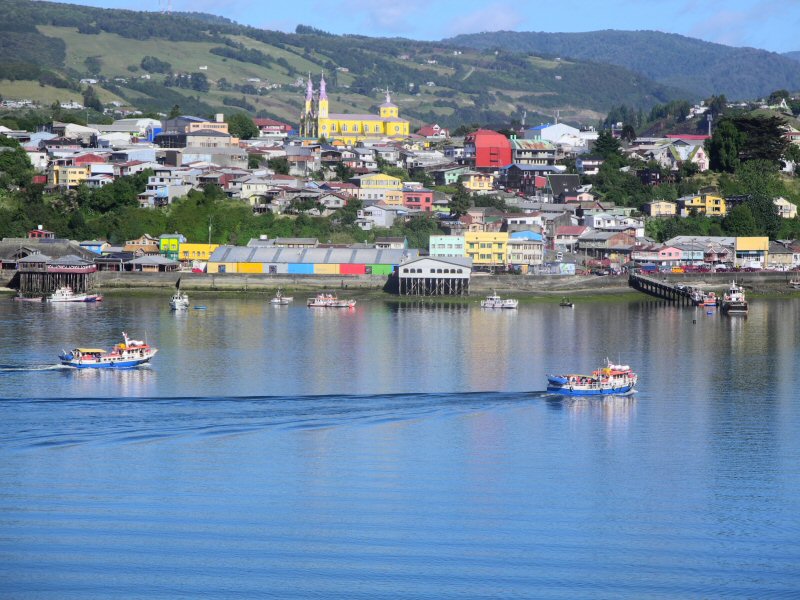
The very charming and colorful port of Castro, Isla Chiloe, Chile
*-*-*
|

A street musician in Castro, Isla Chiloe, Chile. She was accompanied by other band members and a man on stilts.
*-*-*
|
Dec 19, 2017: Puerto Chacabuco, Chile. Today we have another excursion - this time into the Patagonia region of Chile and the capital city of Region 10 - Coyhaique (Coy-I-cay). Along the way we learned that this part of Chile is not really connected to the north by roads and to drive to Santiago, they have to drive into Argentina and then cross back into Chile.
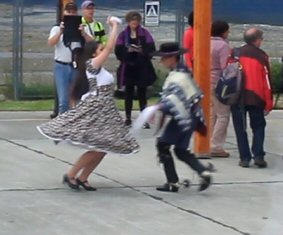
Dancers at the Port of Chacabuco
*-*-*
|

A geological formation seen on the drive from Puerto Chacabuco to Coyhaique, Chile
*-*-*
|
Our first stop is the Simpson Nature Preserve which reminds one, in terms of geography, of Yellowstone without the geysers. Rocky, lush green and cut through by the Simpson River which we were told is popular for fly fishing. There is a nice museum/nature center and a short half mile or so walk along the river which is abundant in wildflowers.
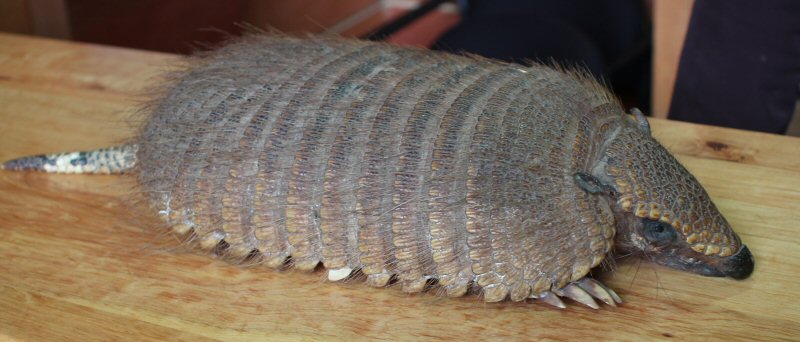
This is a local species of hairy armadillo. He was on display in the nature center.
*-*-*
|
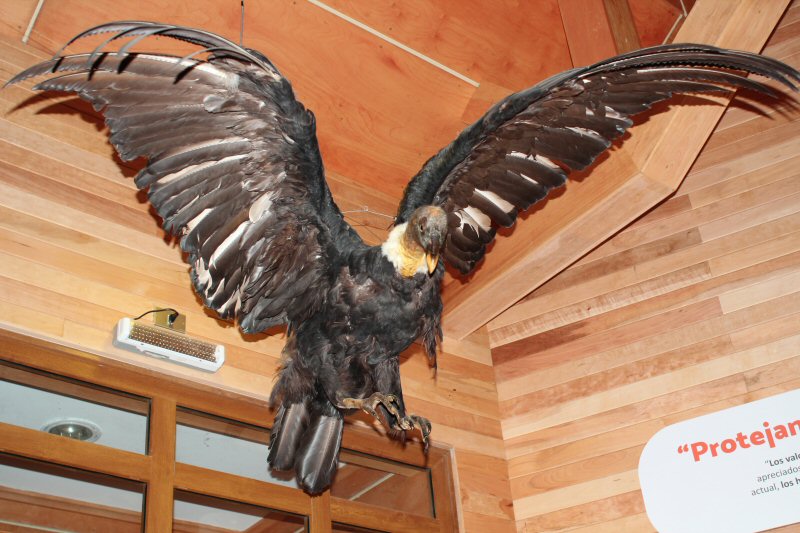
Condors are also indigenous to this region. We haven't seen one in the wild yet, but Barry found this one in the nature center.
*-*-*
|
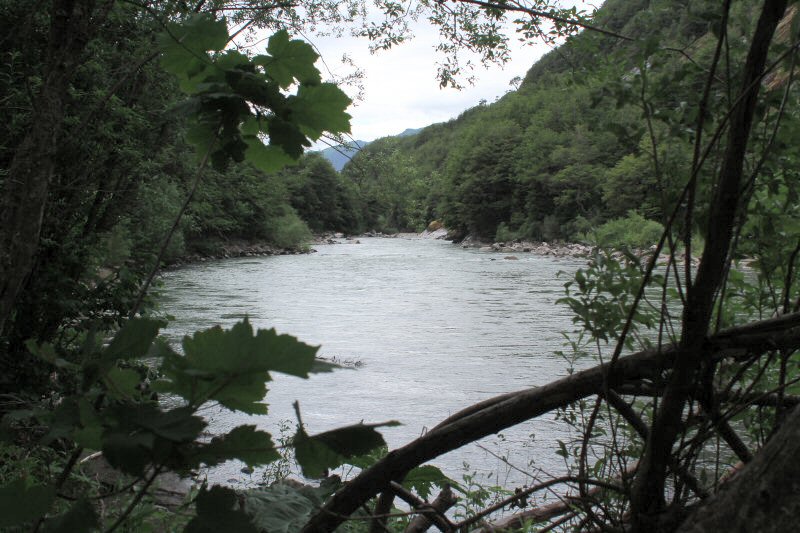
The Simpson River along the nature trail.
*-*-*
|

Flowering tree along the nature trail.
*-*-*
|
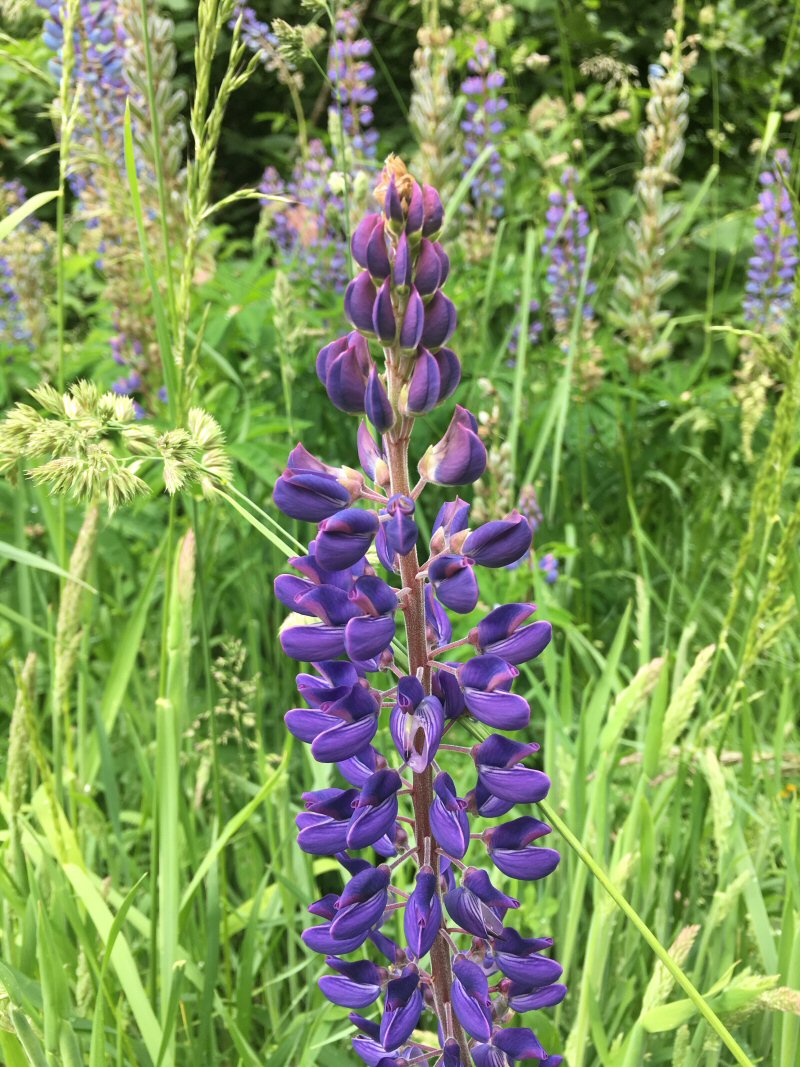
These purple flowers cover the hills of this region of Chile.
*-*-*
|
After leaving the Simpson River Reserve, we traveled further inland and gained elevation to cross the Chilean Andes at about 1500 ft into the western part of Patagonia and arrive in the regional capital city of Coyhaique. We spent an hour wandering the Artisan Markets of the center town square and fortifying ourselves with a piece of chocolate buttercream cake!

A view of Coyhaique from a scenic overlook before descending into the valley to visit the town. This is western Patagonia. As expected it was quite windy, very wide open and breathtaking.
*-*-*
|
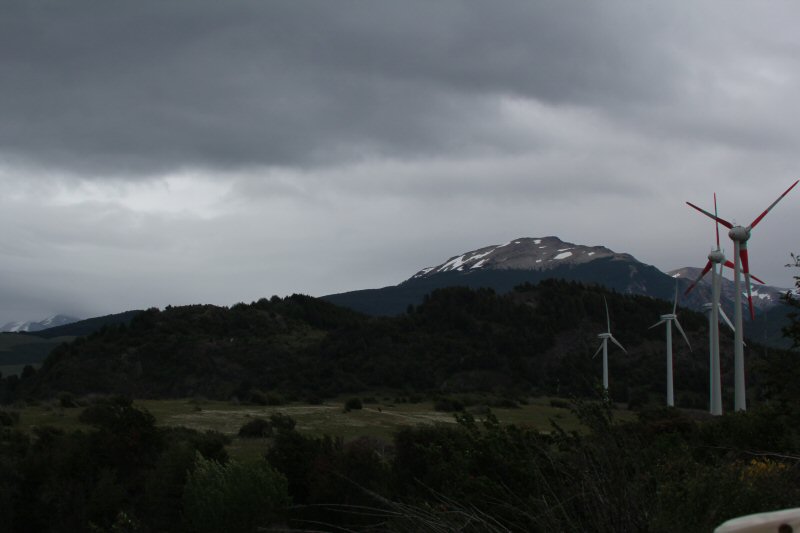
Patagonian windmills supply 35% of the power to this region of Chile, replacing woodburning stoves.
*-*-*
|
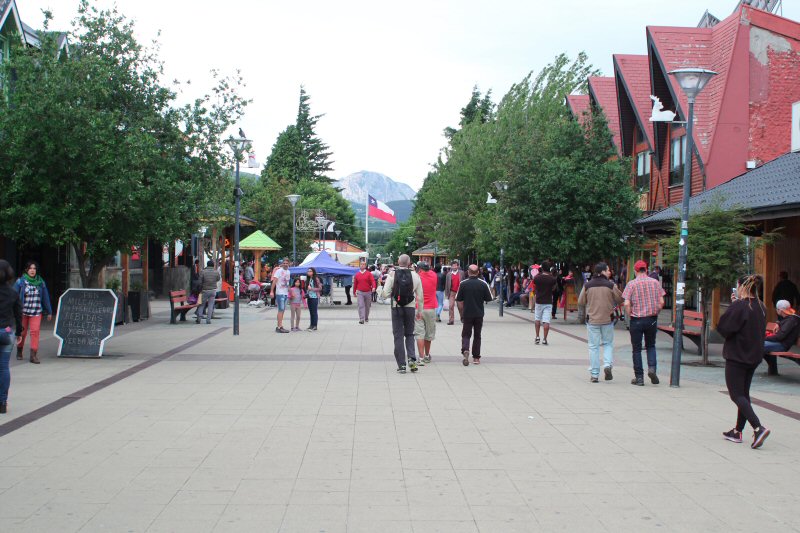
The pedestrian mall in Coyhaique. There were Chilean folk dancers along here entertaining the shoppers. In the foreground is the Chilean Flag which some might mistake for the Texas flag!
*-*-*
|
Next on the agenda was a stop for a snack. We weren't sure what this would entail hence the german chocolate cake. We arrived at what appeared to be two Chilean residences and were directed to the house on the left and down the hill. Inside was an open room set up with a buffet of meat empenadas, fruit, fruit juice, water and wine. The empenadas were very delicious. It was a very tasty snack, indeed. It appeared that this enterprising family had developed a business model for providing food for the tour buses in this rural region where we saw no restaurants. It was a pretty cool idea.
Our final stop was the Waterfall of the Virgin Mary with roadside shrine.
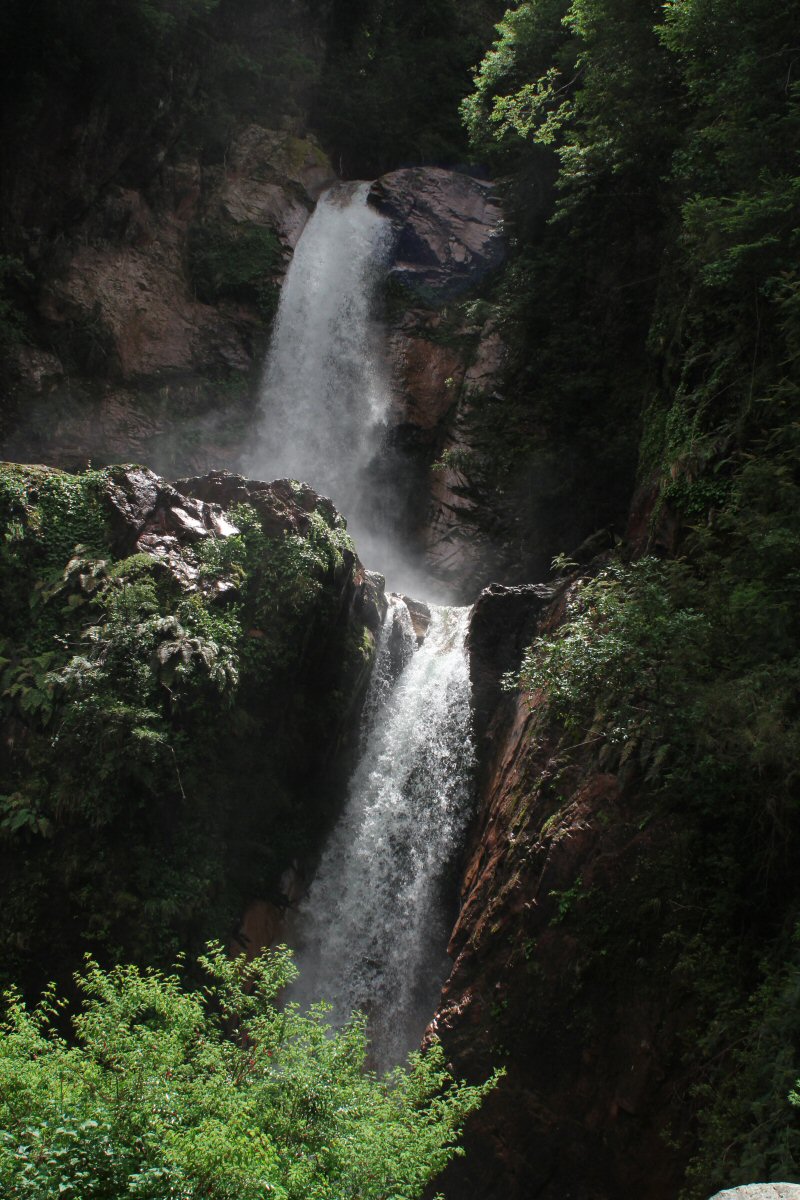
The Waterfall of the Virgin Mary
*-*-*
|
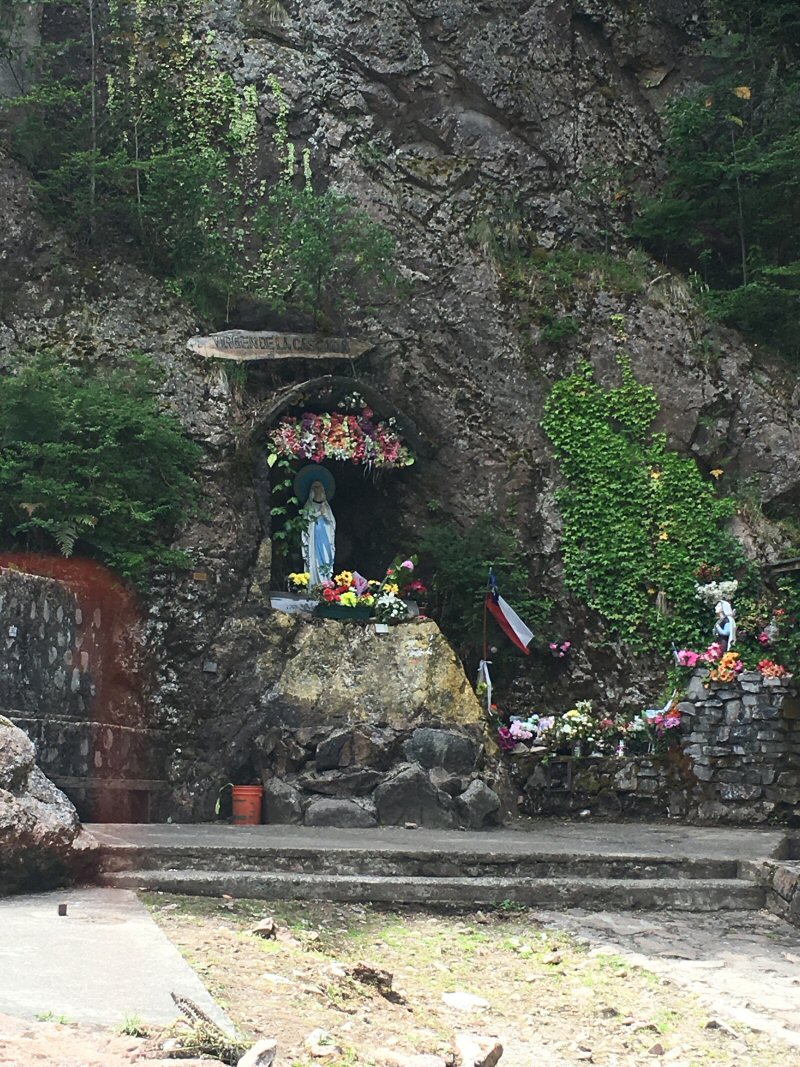
The Shrine to the Virgin Mary
*-*-*
|
After this we headed back to the ship. We were running about 45 minutes late and when we got back to Puerto Chacabuco there was quite a line for the tenders. It had been a very interesting day but we were glad to have two sea days up coming!
The evening show was the Matador of Magic with Joe Devlin and very funny and talented magician whom we thoroughly enjoyed.